Right-click here to download the code examples and required libraries for the book. Unzip the downloaded file into a directory named Irvine on Drive C. Next, Right-click here to download a zip file containing a 32-bit Visual Studio 2015 project. You can extract this file into any folder on your computer. Finally, Right-click here to download a zip file containing a 64-bit Visual Studio 2015 project. You can extract this file into any folder on your computer. Now you are ready to begin the tutorials listed below. Topics:
- Tutorial: Building a 32-Bit Assembly Language Program
- Tutorial: Building and Running a 64-Bit Program
- MASM syntax highlighting
- Creating a 32-Bit Project from Scratch
- Using the Visual Studio debugger
- EXE Programs blocked by antivirus software
Required Setup for 32-bit Applications
When installing Visual Studio, be sure to select Visual C++ under the Programming Languages category. (If you forget to do this, you can always rerun the install file and modify the existing installation.) Visual Studio includes Microsoft Assembler (MASM) version 14. Look for the file named ml.exe in the \vc\bin folder of your Visual Studio installation directory, such as c:\Program Files (x86)\Microsoft Visual Studio 14.0\vc\bin.The Book's Example Programs At the top of this document, we explained how to download the file named Irvine.zip and extract it into the C:\Irvine folder. Unless you have some objection to using that location, do not alter the path. (Note to lab administrators: you can designate c:\Irvine directory as read-only.) If you plan to change the installation location, read our instructions relating to Creating a Project from Scratch.
The folllowing files should appear in the c:\Irvine directory:
| Filename | Description |
| b16.asm, b32.asm | Blank templates for 16-bit and 32-bit assembly language source files |
| GraphWin.inc | Include file for writing Windows applications |
| Irvine16.inc | Include file used with the Irvine16 link library (16-bit applications) |
| Irvine16.lib | 16-bit link function library used with this book |
| Irvine32.inc | Include file used with the Irvine32 link library (32-bit applications) |
| Irvine32.lib | Irvine's 32-bit link library |
| Kernel32.lib | 32-bit link library for Windows API |
| Link16.exe | 16-bit Microsoft linker |
| Macros.inc | Irvine's macro include file (see Chapter 10) |
| make16_vs2012.bat | Visual Studio 2012 batch file for building 16-bit applications |
| make16_vs2013.bat | Visual Studio 2013 batch file for building 16-bit applications |
| SmallWin.inc | Small-sized include file containing MS-Windows definitions, used by Irvine32.inc |
| User32.lib | MS-Windows basic I/O link library |
| VirtualKeys.inc | Keyboard code definitions file, used by Irvine32.inc |
A subdirectory named Examples will contain all the example programs shown in the book, source code for the book's 16-, 32-, and 64-bit libraries, and two sample projects for earlier versions of Visual Studio.
Setting up Visual Studio
You will only have to do these steps the first time you use Visual Studio.Add the Start Without Debugging command to the Debug menu
It's very useful to run programs without having to debug them. To do that, you will want to add a new command to the Debug menu: Start Without Debugging. Here's how to do it:
- From the Tools, menu, select Customize.
- Select the Commands tab.
- Select Menu bar (radio button).
- Click the Add Command button.
- Select Debug from the Categories list.
- Select Start Without Debugging in the right-hand list box.
- Click the OK button.
- Click the Close button.
In fact, you can use the same sequence to customize any of the menus and toolbars in Visual Studio.
Select the C++ Configuration
Visual Studio supports multiple programming languages and application types. The C++ programming language configuration most closely matches that of assembly language programming, so we suggest the following steps:- Select Tools | Import and Export Settings from the menu
- Select the "Import selected environment settings" radio button
- Select the "No, just import..." radio button
- Select "Visual C++" from the Default Settings List and click the Next button
- Click the Finish button, then click the Close button
- Notice the tabs on the left and right sides of the Visual Studio workspace. Close the Server Explorer, Toolbox, and Properties tabs. Use the mouse to drag the Solution Explorer tool window to the right side of the workspace. You can also select other tabs at the bottom of this window, such as "Class View", "Property Manager", and "Team Explorer", and close them. They will not be used in the future. If you need to bring back the Solution Explorer window at any time in the future, select View from the menu, and locate Solution Explorer in the list of views.
Set the Tab Size to 5
(This is an optional step.) Start Visual Studio, and select Options from the Tools menu. Select Text Editor, Select All Languages, and select Tabs. Optionally, you may want to select the Insert spaces radio button:
Set the Tab Size and Indent Size to 5.
Tutorial: Building a 32-Bit Assembly Language Program
Now you're ready to open and build your first 32-bit project.Opening a Project
Visual Studio requires assembly language source files to belong to a project, which is a kind of container. A project holds configuration information such as the locations of the assembler, linker, and required libraries. A project has its own folder, and it holds the names and locations of all files belonging to it.
If you have not already done so,Right-click here to download a zip file containing an up-to-date Visual Studio 2015 project that has been configured for assembly language. After downloading this file, un-zip it into your working directory. It contains a sample asm test file named AddTwo.asm.Do the following steps, in order:
- Start Visual Studio.
- To begin, open our sample Visual Studio project file by selecting File/Open/Project from the Visual Studio menu.
- Navigate to your working folder where you unzipped our project file, and select the file named Project.sln.
- Once the project has been opened, you will see the project name in the Solution Explorer window. You should also see an assembly language source file in the project named AddTwo.asm. Double-click the file name to open it in the editor.
You should see the following program in the editor window:
; AddTwo.asm - adds two 32-bit integers. ; Chapter 3 example .386 .model flat,stdcall .stack 4096 ExitProcess proto,dwExitCode:dword .code main proc mov eax,5 add eax,6 invoke ExitProcess,0 main endp end main |
Build the Program
Now you will build (assemble and link) the sample program. Select Build Project from the Build menu. In the Output window for Visual Studio at the bottom of the screen, you should see messages similar to the following, indicating the build progress:
1>------ Build started: Project: Project, Configuration: Debug Win32 ------ 1> Assembling ..\Project32_VS2015\AddTwo.asm... 1> Project.vcxproj -> ...\Project32_VS2015\Debug\Project.exe ========== Rebuild All: 1 succeeded, 0 failed, 0 skipped ==========
If you do not see these messages, the project has probably not been modified since it was last built. No problem--just select Rebuild Project from the Build menu.
Run the Program
Select Start without Debugging from the Debug menu. The following console window should appear, although your window will be larger than the one shown here:
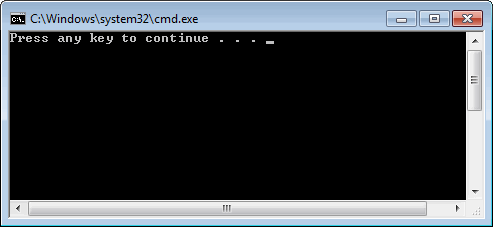
The "Press any key to continue..." message is automatically generated by Visual Studio.
Congratulations, you have just run your first Assembly Language program!
Press any key to close the Console window.
Step 5: Running the Sample Program in Debug Mode
In this step, you set a breakpoint inside the sample program. Then you use the Visual Studio debugger to step through the program's execution one statement at a time.
- Make sure the ASM source code file is open in the editor window.
- To begin stepping through your program in Debug mode, press the F10 key.
- A yellow arrow should appear next to the first program statement.The arrow indicates that the statement is next to be executed.
- Press the F10 key (called Step Over) to execute the current statement. Continue pressing F10 until the program is about to execute the invoke statement.
- A small black window icon should appear on your Windows status bar. Open it and look at the contents of the Command window. The window should be blank because this program does not display any output.
- Press F10 one more time to end the program.

Registers
If you want to display the CPU registers, do the following: Start debugging the program, then select Windows from the Debug menu. Select Registers from the drop-down list. The Registers window may appear at the bottom of the workspace, as a tab highlighted in yellow. Use the mouse to drag the window to the right side of the work area. Right click inside the Registers window and check the item Flags to enable the display of CPU status flags.
You can interrupt a debugging session at any time by selecting Stop Debugging from the Debug menu. You can do the same by clicking the maroon-colored square button on the toolbar. To remove a breakpoint from the program, click on its red dot to make it disappear.
Setting a BreakPoint
If you set a breakpoint in a program, you can use the debugger to execute the program a full speed (more or less) until it reaches the breakpoint. At that point, the debugger drops into single-step mode.
- In our sample program, click the mouse along the border to the left of the mov eax,5 statement. A large red dot should appear in the margin.
- Select Start Debugging from the Debug menu. The program should run, and pause on the line with the breakpoint, showing the same Yellow arrow as before.
- Press F10 until the program finishes.
You can remove a breakpoint by clicking its red dot with the mouse. Take a few minutes to experiment with the Debug menu commands. Set more breakpoints and run the program again. For the time being, you can use the F11 key to step through the program in the same way the F10 key did.
Building and Running Other Programs
Suppose you want to run another example program, or possibly create your own program. You can remove the existing assembly language file from the Solution Explorer window and insert a new .asm file into the project.
- To remove a program from a project without deleting the file, right-click its name in the Solution Explorer window. In the context menu, select Remove. If you change your mind and decide to add it back to the project, right-click in the same window, select Add, select Existing item, and select the file you want to add.
Adding a File to a Project
An easy way to add an assembly language source file to an open project is to drag its filename with the mouse from a Windows Explorer window onto the name of your project in the Solution Explorer window. The physical file will not be copied--the project only holds a reference to the file's location. Try this now:
- Remove the AddTwo.asm file from your project.
- Add a reference to the file Examples\ch03\AddTwoSum.asm to the project.
- Build and run the project.
Copying a Source File
One way to make a copy of an existing source code file is to use Windows Explorer to copy the file into your project directory. Then, right-click the project name in Solution Explorer, select Add, select Existing Item, and select the filename.
Tutorial: Building and Running a 64-Bit Program
In this tutorial, we will show you how to assemble, link, and run a sample 64-bit program. We assume you have already completed our tutorial entitled Building a 32-Bit Assembly Language Program.Do the following steps, in order:
- Right-click here to download the Project64_VS2015.zip file and unzip it into your working directory.
- In Visual Studio 2015, select Open Project from the File menu, navigate to the Project64_VS2015 folder, and select the file named Project.sln.
- You are about to add an existing source code file to the project. To do that, right-click on Project in the Solution Explorer window, select Add, select Existing Item, navigate to the book's Examples\ch03\64 bit" folder, select AddTwoSum_64.asm, and click the Add button to close the dialog window.
- Open the AddTwoSum_64.asm file for editing by double-clicking its filename in the Solution Explorer window.
You should see the following program in the editor window:
; AddTwoSum_64.asm - Chapter 3 example. ExitProcess proto .data sum qword 0 .code main proc mov rax,5 add rax,6 mov sum,rax mov ecx,0 call ExitProcess main endp end(Notice that the program's entry point is the main procedure. If you wish to use a different name for your startup procedure in your own programs, you can modify this option by selecting Properties from the Project menu, and then selecting Linker / Advanced / Entry Point.)
Build the Program
Select Build Project from the Build menu. You should see text written to Visual Studio's output window like the following:1>------ Build started: Project: Project, Configuration: Debug x64 ------ 1> Assembling ..\examples\ch03\64 bit\AddTwoSum_64.asm... 1> Project64_VS2015.vcxproj -> D:\Asmbook 7\Project64_VS2015\x64\Debug\Project.exe 1> Project64_VS2015.vcxproj -> D:\Asmbook 7\Project64_VS2015\x64\Debug\Project.pdb (Full PDB) ========== Build: 1 succeeded, 0 failed, 0 up-to-date, 0 skipped ==========If you do not see these messages, the project has probably not been modified since it was last built. No problem--just select Rebuild Project from the Build menu. You use the same Visual Studio commands to run and debug 64-bit programs as you would for 32-bit programs.
Building 16-bit Applications (Chapters 14-17)
Only Chapters 14 through 17 require you to build 16-bit applications. Except for a few exceptions, which are noted in the book, your 16-bit applications will run under the 32-bit versions of Windows (XP, Vista, 7). But 16-bit applications will not run directly in any 64-bit version of Windows.
If you plan to build 16-bit applications, you need to add two new commands to the Visual Studio Tools menu. To add a command, select External Tools from the Tools menu. The following dialog will appear, although many of the items in your list on the left side will be missing. The filename in the sample image (make16.bat) has been replaced by two files:
- make16_vs2012.bat for Visual Studio 2012)
- make16_vs2013.bat for Visual Studio 2013)

Step 1: Create the Build 16-bit ASM Command
Click the Add button and fill in the Title, Command, Arguments, and Initial directory fields as shown in the screen snapshot. If you click the buttons with arrows on the right side of the Arguments and Initial directory fields, a convenient list appears. You can select an item without having to worry about spelling:
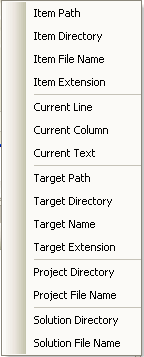
Click the Apply button to save the command.
Step 2: Create the Run 16-bit ASM Command
Click the Add button again, and create a new command named Run 16-bit ASM:

Uncheck the "Close on exit" option and click the OK button to save the command and close the External Tools dialog.
Testing Your new 16-Bit Commands
To test your new 16-bit commands, close any Visual Studio project that happens to be open. Then, select File | Open | File from the menu and choose the file named 16-bit.asm from the ch03 folder in the book's example programs. Select Build 16-bit ASM from the Tools menu. The following command window should appear, showing the successful execution of the assembler and linker, followed by a listing of all files related to this program:
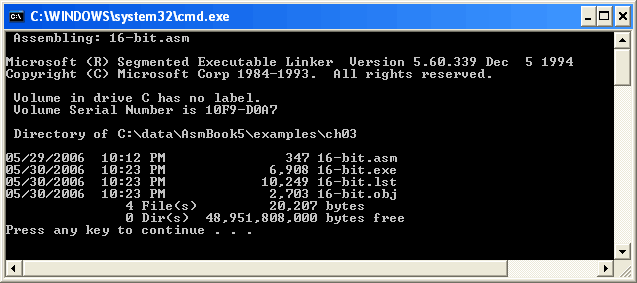
Press a key to close the window. Next, you will run the program. Select Run 16-bit ASM from the Tools menu. The following window will appear, although the contents of all registers except EAX will be different:

Press a key to close the window.
You have completed the setup for building and running 16-bit assembly language programs.
Creating a 32-Bit Project From Scratch
Visual Studio makes it possible (in 14 steps!) to create an Assembly Language project from scratch. You must create a Win32 Console application designed for C++ and modify various settings.Step 1: Select New from the File menu, then select Project. In the New Project window, select Win32 under Visual C++ in the left panel, and select Win32 Console Application in the middle panel. Give your project a suitable name (near the bottom of the window):

(Depending on your Visual Studio configuration, you might have to find Visual C++ under the "Other Languages" category in the left panel.)
Step 2: Click the OK button to continue. The Win32 Application Wizard window will appear. Select Application Settings, and then select the Empty project check box.

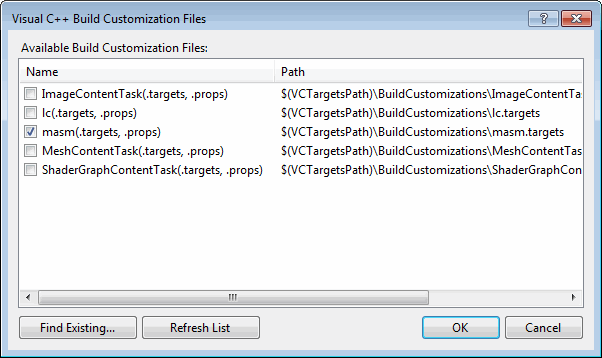 Step 6: You're almost ready to set the assembler properties. But first, you must help Visual
Studio associate source code files having the .asm extension with the Microsoft Macro Assembler. To do this,
right-click the .asm file in the Solution Explorer window, select Properties from
the popup window, click on Item Type in the right-hand pane, scroll down the list, and select
Microsoft Macro Assembler. Click OK to close the dialog window.
Step 7:
Right-click the project name in the Solution Explorer window and select Properties from
the popup menu. Expand the entry under Configuration Properties.
Then expand the entry named Microsoft Macro Assembler. This
is what you should see:
Step 6: You're almost ready to set the assembler properties. But first, you must help Visual
Studio associate source code files having the .asm extension with the Microsoft Macro Assembler. To do this,
right-click the .asm file in the Solution Explorer window, select Properties from
the popup window, click on Item Type in the right-hand pane, scroll down the list, and select
Microsoft Macro Assembler. Click OK to close the dialog window.
Step 7:
Right-click the project name in the Solution Explorer window and select Properties from
the popup menu. Expand the entry under Configuration Properties.
Then expand the entry named Microsoft Macro Assembler. This
is what you should see:


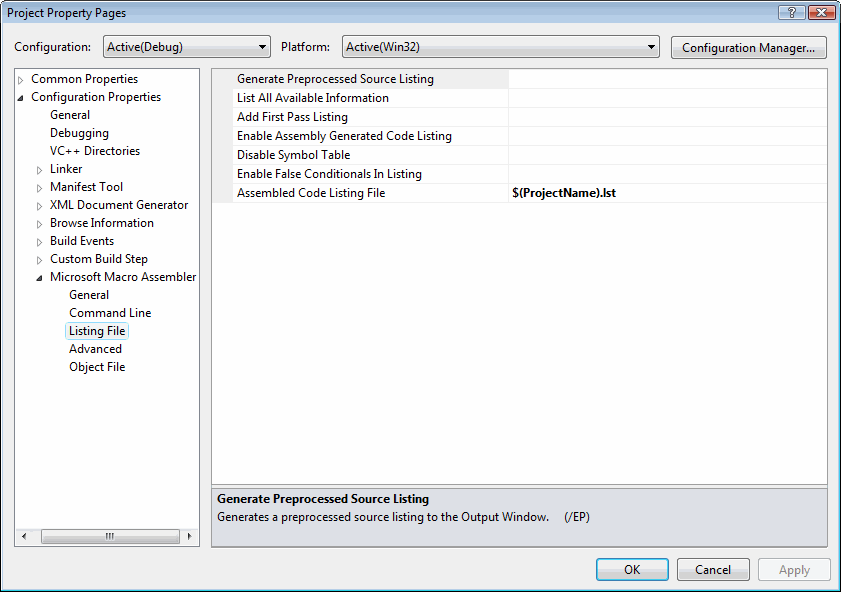
 Step 11: Select Linker under Configuration Properties, and then select
General. The Additional Library Directories entry must contain
c:\Irvine so the linker can find the Irvine32.lib library file:
Step 11: Select Linker under Configuration Properties, and then select
General. The Additional Library Directories entry must contain
c:\Irvine so the linker can find the Irvine32.lib library file:

Step 12: Select Linker under the Configuration Properties and select Debugging. Verify that the Generate Debug Info option is equal to Yes(/DEBUG)
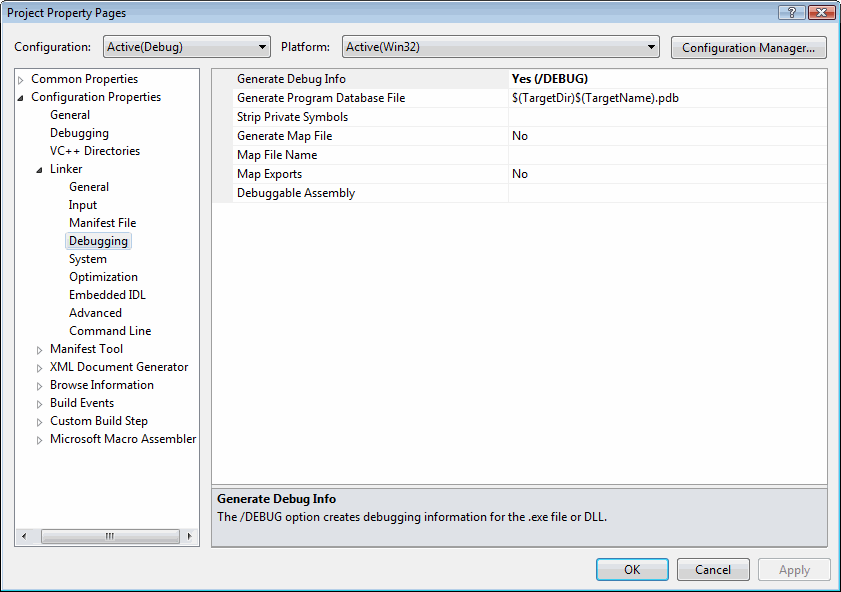
Step 13: Select Advanced under the Linker entry. Set the Image Has Safe Exception Handlers option to No.

Generating a Source Listing File
Open the project. From the menu, select Project, select Properties. In the list box, select Microsoft Macro Assembler, then select Listing File. Set the Assembled Code Listing file option to $(InputName).lst. Return to topMASM syntax highlighting
When a text editor uses syntax highlighting, language keywords, strings, and other elements appear in different colors. Visual Studio highlights MASM reserved words and strings, as shown in the following example:

This won't happen automatically, but you can create a syntax definition file named Usertype.dat that contains MASM keywords. Then when Visual Studio starts, it reads the syntax file and highlights MASM keywords.
If you decide to use Visual Studio's built-in MASM syntax highlighter, here are the required steps to set it up:
1) Download the Usertype.dat file (enclosed in a ZIP file) given here to a folder in which you have read/write permissions. If you are using Windows 7, download to My Documents, or C:\temp, or any folder that doesn't have security restrictions.
2) Copy Usertype.dat to the C:\Program Files\Microsoft Visual Studio 12.x\Common7\IDE folder. In 64-bit windows, Program Files will be named Program Files(x86).
Windows will display a verification dialog before copying the file.3) Open Visual Studio, select Options from the Tools menu, select Text Editor, and select File Extension. On the right side of the dialog (shown below), enter asm as the extension, select Microsoft Visual C++ from the Editor list, and click the Add button. Click the OK button to save your changes.
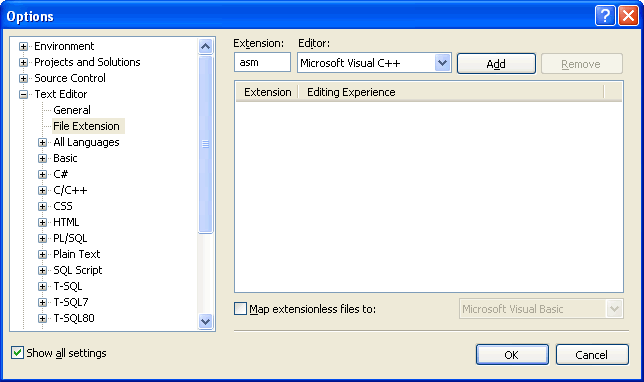
;// AddTwo.asm - adds two 32-bit integers. ;// Chapter 3 exampleReturn to top
